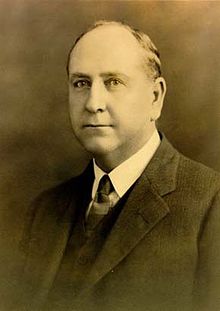- Philip Collier
-
Philip Collier 
14th Premier of Western Australia In office
17 April 1924 – 23 April 1930Preceded by Sir James Mitchell Succeeded by Sir James Mitchell In office
24 April 1933 – 19 August 1936Preceded by Sir James Mitchell Succeeded by John Willcock Constituency Boulder Personal details Born 21 April 1873
Woodstock, VictoriaDied 18 October 1948 (aged 75)
Mount LawleyNationality Australian Political party Australian Labor Party Spouse(s) Ellen Heagney Philip Collier (21 April 1873–18 October 1948) was Premier of Western Australia for nine years, the longest ever term for an Australian Labor Party premier.
Philip Collier was born at Woodstock near Melbourne, Victoria on 21 April 1873. The son of a farmer of the same name, he was educated locally but left school at the age of 16. He spent some time gold mining at Steiglitz, Victoria and then in New South Wales, and was later construction foreman of the Greater Melbourne Sewage Company at Northcote. On 27 June 1900, he married Ellen Heagney, with whom he would have two sons and two daughters.
Collier began to take an interest in the labor movement, joining the Labour Party and becoming founding secretary of the Northcote branch of the Political Labor Council. He was campaign director for at least three Labour candidates in State and Federal election, including Frank Anstey.
In 1904 Collier moved to Western Australia. He worked in the mines of the Perseverance Goldmining Company for around a year, becoming a member of the Boulder branch of the Amalgamated Workers' Association, and vice-president of the Goldfields Trades and Labour Council.
On 27 October 1905, Collier was elected to the Western Australian Legislative Assembly for the seat of Boulder. He would retain the seat until his death nearly 43 years later. He was appointed Minister for Mines and Minister for Railways in the Scaddan Ministry on 7 October 1911, exchanging the Railways portfolio for Water Supplies on 23 November 1914. He retained these portfolios until the defeat of the Scaddan government on 17 July 1916. In April the following year, Scaddan resigned from the Australian Labor Party in support of Billy Hughes's pro-conscriptionist stance, and on 9 May Collier was elected to take his place as Leader of the Labor Party and therefore Leader of the Opposition.
Collier retained the leadership of the Labor party throughout the Liberal and nationalist governments of Frank Wilson, Henry Lefroy, Hal Colebatch and James Mitchell. During this time Collier joined with John Curtin and J. J. Simons in leading an anti-conscription campaign. His public comments got him in trouble with censors a number of times, and on one occasion he was fined under the War Precautions Act for making statements likely to discourage recruiting.
On 17 April 1924, the Labor party had a landslide election victory, and Collier became Premier, Treasurer and Minister for Forests. The Labor party was defeated by Mitchell in the election of 23 April 1930, whereupon Collier resumed as Leader of the Opposition. He won another term as Premier in the election of 24 April 1933. Simultaneously with the election, a referendum had been held in which the people of Western Australia had overwhelmingly voted in favour of secession from the Commonwealth of Australia. Although the Labour party opposed secession, Collier nonetheless agreed to act on the result of the referendum by petitioning the British government for secession. The British government's refusal to act can be partly attributed to the fact that any action taken would have been in opposition to the new Government's wishes.
Collier resigned as premier and leader of the Labor party on 19 August 1936, handing over to John Willcock. His 19 year term as parliamentary leader of the Australian Labor Party remains the longest ever, as does his 9 year term as Labor premier. Victor Courtney (1956) describes him as "the only person Labour [sic] produced in State politics who could fairly claim to have approached statesmanship". Mitchell and Collier are together credited with achieving an unusual degree of friendship and cooperation between parties during the 1920s and 1930s, which was most clearly demonstrated by Collier recommending Mitchell's appointment as Lieutenant-Governor in 1933.
Although no longer serving as a minister, Collier remained in parliament for a further twelve years, and was Father of the House from March 1939. He died at Mount Lawley on 18 October 1948, and was buried in Karrakatta Cemetery.
References
- Black, David and Bolton, Geoffrey (2001). Biographical Register of Members of the Parliament of Western Australia, Volume One, 1870–1930 (Revised Edition ed.). Parliament House: Parliament of Western Australia. ISBN 0730738140.
- Courtney, Victor (1956). All I May Tell: A Journalist's Story. Sydney: Shakespeare Head Press.
- Reid, Gordon Stanley and Oliver, Margaret Ruth (1982). The Premiers of Western Australia 1890–1982. Nedlands, Western Australia: University of Western Australia Press. ISBN 0-85564-214-9.
Further reading
The following sources were not used in the writing of this article:
- Black, David (1959). "The Collier Government, 1924-1930". University Studies in History 3 (3): 58–70.
Preceded by
Sir James MitchellPremier of Western Australia
1924 – 1930Succeeded by
Sir James MitchellPreceded by
Sir James MitchellPremier of Western Australia
1933 – 18 August 1936Succeeded by
John WillcockPremiers of Western Australia Forrest · Throssell · Leake · Morgans · Leake · James · Daglish · Rason · Moore · Wilson · Scaddan · Wilson · Lefroy · Colebatch · Mitchell · Collier · Mitchell · Collier · Willcock · Wise · McLarty · Hawke · Brand · Tonkin · C. Court · O'Connor · Burke · Dowding · Lawrence · R. Court · Gallop · Carpenter · Barnett Categories:
Categories:- 1873 births
- 1948 deaths
- Australian Labor Party politicians
- Burials at Karrakatta Cemetery
- Leaders of the Opposition in Western Australia
- Members of the Western Australian Legislative Assembly
- People from Victoria (Australia)
- Premiers of Western Australia
- Treasurers of Western Australia
Wikimedia Foundation. 2010.
